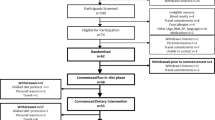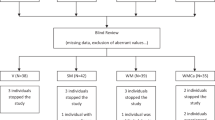Abstract
Background:
Many studies have shown that trans fatty acids have unfavorable effects on the serum lipoprotein profile. In general, however, fats were compared with different functional characteristics, which lower the practical applications of the results.
Objective:
The major aim of this study was to compare the effects of a high-palmitic acid, trans-free semiliquid fat with those of a high-oleic acid, low-trans semiliquid fat on the serum lipoprotein profile of healthy subjects.
Subjects and design:
Forty-four subjects (33 women and 11 men) consumed, in random order, two experimental diets, each for 3 weeks. Diets provided 40 energy percent (En%) from fat, while 15 En% was supplied by the experimental fats. At the end of each intervention period, concentrations of serum lipoproteins, C-reactive protein, glucose and insulin were measured.
Results:
When subjects consumed the high-oleic acid, low-trans semiliquid fat, intakes of stearic acid (+1.3 En%), oleic acid (+2.9 En%), α-linolenic acid (+0.1 En%) and trans fatty acids (+0.6 En%) were higher and that of palmitic acid (−4.2 En%) lower. Serum concentration of low-density lipoprotein cholesterol decreased by 0.34±0.39 mmol/l (mean±s.d.; 95% confidence interval (CI), −0.46 to −0.23 mmol/l; P<0.001) and high-density lipoprotein (HDL) cholesterol by −0.06±0.17 mmol/l (95% CI, −0.11 to −0.01 mmol/l; P=0.021). Also, the total to HDL cholesterol ratio was lower (−0.15±0.34; 95% CI, −0.25 to −0.05; P=0.006). Other parameters did not change.
Conclusions:
A high-oleic acid, low-trans semiliquid fat has a more favorable effect on the serum lipoprotein profile than a trans-free semiliquid fat with comparable functional characteristics, but high in palmitic acid.
This is a preview of subscription content, access via your institution
Access options
Subscribe to this journal
Receive 12 print issues and online access
$259.00 per year
only $21.58 per issue
Buy this article
- Purchase on Springer Link
- Instant access to full article PDF
Prices may be subject to local taxes which are calculated during checkout
Similar content being viewed by others
References
Ascherio A, Katan MB, Zock PL, Stampfer MJ, Willett WC (1999). Trans fatty acids and coronary heart disease. N Engl J Med 340, 1994–1998.
Baer DJ, Judd JT, Clevidence BA, Tracy RP (2004). Dietary fatty acids affect plasma markers of inflammation in healthy men fed controlled diets: a randomized crossover study. Am J Clin Nutr 79, 969–973.
Bemelmans WJ, Lefrandt JD, Feskens EJ, van Haelst PL, Broer J, Meyboom-de Jong B et al. (2004). Increased alpha-linolenic acid intake lowers C-reactive protein, but has no effect on markers of atherosclerosis. Eur J Clin Nutr 58, 1083–1089.
Bligh EG, Dyer WJ (1959). A rapid method of total lipid extraction and purification. Can J Biochem Physiol 37, 911–917.
Castelli WP (1996). Lipids, risk factors and ischaemic heart disease. Atherosclerosis 124 (Suppl), S1–S9.
Centraal begeleidingsorgaan voor de intercollegiale toetsing (1998). Behandeling en preventie van coronaire hartziekten door verlaging van de plasma cholesterolconcentratie (Treatment and prevention of coronary heart disease by lowering plasma cholesterol concentrations). In: Centraal begeleidingsorgaan voor de intercollegiale toetsing. Utrecht: The Netherlands.
Christiansen E, Schnider S, Palmvig B, Tauber-Lassen E, Pedersen O (1997). Intake of a diet high in trans monounsaturated fatty acids or saturated fatty acids. Effects on postprandial insulinemia and glycemia in obese patients with NIDDM. Diabetes Care 20, 881–887.
Dijkstra AJ (2006). Revisiting the formation of trans isomers during partial hydrogenation of triacylglycerol oils. Eur J Lipid Sci Technol 108, 249–264.
NEVO (2001). Dutch Food Composition Table 2001. In: Stichting. The Hague: The Netherlands.
Friedewald WT, Levy RI, Fredrickson DS (1972). Estimation of the concentration of low-density lipoprotein cholesterol in plasma, without use of the preparative ultracentrifuge. Clin Chem 18, 499–502.
Huddleston DJ, Deitrick CL, Budrean SA, Katholi RE (2001). Performance characteristics of an automated method for high-sensitivity CRP on the Roche cobas mira analyzer. JALA 6, 32–33.
Kaluzny MA, Duncan LA, Merritt MV, Epps DE (1985). Rapid separation of lipid classes in high yield and purity using bonded phase columns. J Lipid Res 26, 135–140.
Katan MB, Grundy SM, Jones P, Law M, Miettinen T, Paolett R for the Stresa workshop participants (2003). Efficacy and safety of plant stanols and sterols in the management of blood cholesterol levels. Mayo Clin Proc 78, 965–978.
Lichtenstein AH, Erkkilä AT, Lamarche B, Schwab US, Jalbert SM, Ausman LM (2003). Influence of hydrogenated fat and butter on CVD risk factors: remnant-like particles, glucose and insulin, blood pressure and C-reactive protein. Atherosclerosis 171, 97–107.
Lopez-Garcia E, Schulze MB, Meigs JB, Manson JE, Rifai N, Stampfer MJ, Willett WC, Hu FB (2005). Consumption of trans fatty acids is related to plasma biomarkers of inflammation and endothelial dysfunction. J Nutr 135, 562–566.
Louheranta AM, Turpeinen AK, Vidgren HM, Schwab US, Uusitupa MIJ (1999). A high-trans fatty acid diet and insulin sensitivity in young healthy women. Metabolism 48, 870–875.
Lovejoy JC, Smith SR, Champagne CM, Most MM, Lefevre M, DeLany JP et al. (2002). Effects of diets enriched in saturated (palmitic), monounsaturated (oleic), or trans (elaidic) fatty acids on insulin sensitivity and substrate oxidation in healthy adults. Diabetes Care 25, 1283–1288.
Mensink RP, Zock PL, Kester AD, Katan MB (2003). Effects of dietary fatty acids and carbohydrates on the ratio of serum total to HDL cholesterol and on serum lipids and apolipoproteins: a meta-analysis of 60 controlled trials. Am J Clin Nutr 77, 1146–1155.
Meyer KA, Kushi LH, Jacobs Jr DR, Folsom AR (2001). Dietary fat and incidence of type 2 diabetes in older Iowa women. Diabetes Care 24, 1528–1535.
Morrison WR, Smith LM (1964). Preparation of fatty acid methyl esters and dimethylacetals from lipids with boron fluoride–methanol. J Lipid Res 5, 600–608.
Mozaffarian D, Pischon T, Hankinson SE, Rifai N, Joshipura K, Willett WC et al. (2004). Dietary intake of trans fatty acids and systemic inflammation in women. Am J Clin Nutr 79, 606–612.
Muller H, Jordal O, Kierulf P, Kirkhus B, Pedersen JI (1998). Replacement of partially hydrogenated soybean oil by palm oil in margarine without unfavorable effects on serum lipoproteins. Lipids 33, 879–887.
Pedersen A, Baumstark MW, Marckmann P, Helena Gylling H, Sandström B (2000). An olive oil-rich diet results in higher concentrations of LDL cholesterol and a higher number of LDL subfraction particles than rapeseed oil and sunflower oil diets. J Lipid Res 41, 1901–1910.
Pocock SJ (1987). Clinical trials: A Practical Approach. John Wiley and Sons: Chichester.
Report of a Joint WHO/FAO Expert Consultation (2002). Diet, Nutrition and the Prevention of Chronic Diseases. In: WHO Technical Report Series 916. WHO: Geneva.
Rimm EB, Williams P, Fosher K, Criqui M, Stampfer MJ (1999). Moderate alcohol intake and lower risk of coronary heart disease: meta-analysis of effects on lipids and haemostatic factors. BMJ 319, 1523–1528.
Salméron J, Hu FB, Manson JE, Stampfer MJ, Colditz GA, Rimm EB, Willett WC (2001). Dietary fat intake and risk of type 2 diabetes in women. Am J Clin Nutr 73, 1019–1026.
Stampfer MJ, Sacks FM, Salvini S, Willett WC, Hennekens CH (1991). A prospective study of cholesterol, apolipoproteins, and the risk of myocardial infarction. N Engl J Med 325, 373–381.
Van Dam RM, Willett WC, Rimm EB, Stampfer MJ, Hu FB (2002). Dietary fat and meat intake in relation to risk of type 2 diabetes in men. Diabetes Care 25, 417–424.
Wensing AG, Mensink RP, Hornstra G (1999). Effects of dietary n-3 polyunsaturated fatty acids from plant and marine origin on platelet aggregation in healthy elderly subjects. Br J Nutr 82, 183–191.
Zhao G, Etherton TD, Martin KR, West SG, Gillies PJ, Kris-Etherton PM (2004). Dietary alpha-linolenic acid reduces inflammatory and lipid cardiovascular risk factors in hypercholesterolemic men and women. J Nutr 134, 2991–2997.
Acknowledgements
We thank the support of the members of our technical staff. We also thank all participants for their cooperation and interest. This work was supported by a research grant from Cargill Refined Oils Europe, Schiedam, The Netherlands.
Author information
Authors and Affiliations
Corresponding author
Rights and permissions
About this article
Cite this article
Mensink, R. Effects of products made from a high-palmitic acid, trans-free semiliquid fat or a high-oleic acid, low-trans semiliquid fat on the serum lipoprotein profile and on C-reactive protein concentrations in humans. Eur J Clin Nutr 62, 617–624 (2008). https://doi.org/10.1038/sj.ejcn.1602756
Received:
Revised:
Accepted:
Published:
Issue Date:
DOI: https://doi.org/10.1038/sj.ejcn.1602756



